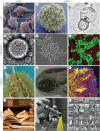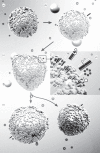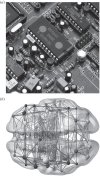The major synthetic evolutionary transitions
- PMID: 27431528
- PMCID: PMC4958944
- DOI: 10.1098/rstb.2016.0175
The major synthetic evolutionary transitions
Abstract
Evolution is marked by well-defined events involving profound innovations that are known as 'major evolutionary transitions'. They involve the integration of autonomous elements into a new, higher-level organization whereby the former isolated units interact in novel ways, losing their original autonomy. All major transitions, which include the origin of life, cells, multicellular systems, societies or language (among other examples), took place millions of years ago. Are these transitions unique, rare events? Have they instead universal traits that make them almost inevitable when the right pieces are in place? Are there general laws of evolutionary innovation? In order to approach this problem under a novel perspective, we argue that a parallel class of evolutionary transitions can be explored involving the use of artificial evolutionary experiments where alternative paths to innovation can be explored. These 'synthetic' transitions include, for example, the artificial evolution of multicellular systems or the emergence of language in evolved communicating robots. These alternative scenarios could help us to understand the underlying laws that predate the rise of major innovations and the possibility for general laws of evolved complexity. Several key examples and theoretical approaches are summarized and future challenges are outlined.This article is part of the themed issue 'The major synthetic evolutionary transitions'.
Keywords: artificial life; evolutionary robotics; major transitions; phase transitions; synthetic biology.
© 2016 The Author(s).
Figures



Similar articles
-
Synthetic transitions: towards a new synthesis.Philos Trans R Soc Lond B Biol Sci. 2016 Aug 19;371(1701):20150438. doi: 10.1098/rstb.2015.0438. Philos Trans R Soc Lond B Biol Sci. 2016. PMID: 27431516 Free PMC article. Review.
-
Evolutionary transitions during RNA virus experimental evolution.Philos Trans R Soc Lond B Biol Sci. 2016 Aug 19;371(1701):20150441. doi: 10.1098/rstb.2015.0441. Philos Trans R Soc Lond B Biol Sci. 2016. PMID: 27431519 Free PMC article. Review.
-
Viruses and mobile elements as drivers of evolutionary transitions.Philos Trans R Soc Lond B Biol Sci. 2016 Aug 19;371(1701):20150442. doi: 10.1098/rstb.2015.0442. Philos Trans R Soc Lond B Biol Sci. 2016. PMID: 27431520 Free PMC article. Review.
-
Agent-based models for the emergence and evolution of grammar.Philos Trans R Soc Lond B Biol Sci. 2016 Aug 19;371(1701):20150447. doi: 10.1098/rstb.2015.0447. Philos Trans R Soc Lond B Biol Sci. 2016. PMID: 27431525 Free PMC article.
-
Nascent life cycles and the emergence of higher-level individuality.Philos Trans R Soc Lond B Biol Sci. 2017 Dec 5;372(1735):20160420. doi: 10.1098/rstb.2016.0420. Philos Trans R Soc Lond B Biol Sci. 2017. PMID: 29061893 Free PMC article.
Cited by
-
Synthetic eco-evolutionary dynamics in simple molecular environment.Elife. 2024 Mar 26;12:RP90156. doi: 10.7554/eLife.90156. Elife. 2024. PMID: 38530348 Free PMC article.
-
A rubric for human-like agents and NeuroAI.Philos Trans R Soc Lond B Biol Sci. 2023 Jan 30;378(1869):20210446. doi: 10.1098/rstb.2021.0446. Epub 2022 Dec 13. Philos Trans R Soc Lond B Biol Sci. 2023. PMID: 36511409 Free PMC article. Review.
-
Darwin's agential materials: evolutionary implications of multiscale competency in developmental biology.Cell Mol Life Sci. 2023 May 8;80(6):142. doi: 10.1007/s00018-023-04790-z. Cell Mol Life Sci. 2023. PMID: 37156924 Free PMC article. Review.
-
Molecular phylogenetics and evolutionary analysis of a highly recombinant begomovirus, Cotton leaf curl Multan virus, and associated satellites.Virus Evol. 2021 Jun 4;7(2):veab054. doi: 10.1093/ve/veab054. eCollection 2021. Virus Evol. 2021. PMID: 34532058 Free PMC article.
-
Behaviorist approaches to investigating memory and learning: A primer for synthetic biology and bioengineering.Commun Integr Biol. 2021 Dec 14;14(1):230-247. doi: 10.1080/19420889.2021.2005863. eCollection 2021. Commun Integr Biol. 2021. PMID: 34925687 Free PMC article. Review.
References
-
- Wood G. 2003. Living dolls: a magical history of the quest for mechanical life. New York, NY: Faber.
-
- Langton CG. 1986. Studying artificial life with cellular automata. Physica D 22, 120–149. (10.1016/0167-2789(86)90237-X) - DOI
-
- De Vries H. 1904. Species and varieties: their origin by mutation. London, UK: Open court publishing Company.
-
- Maynard-Smith J, Szathmáry E. 1995. The major transitions in evolution. Oxford, UK: Oxford University Press.
Publication types
MeSH terms
LinkOut - more resources
Full Text Sources
Other Literature Sources

